2017 Yamaha SCR950 First Ride Review

Doubling down on Sport Heritage offerings
The SCR950 is the second Yamaha press intro this year offering a re-stylized version of an existing model – the first one being the XSR900 launched a few months ago and reviewed here. With the XSR Yamaha took the laudable FZ-09, dressed it in vintage ’70s attire, and upgraded the bike’s performance with better suspension and some (ironically) modern electronics. For the SCR, Yamaha took the popular Bolt model, stirred in some select features from the C-Spec, added a seamless tank, reimagined it as a Scrambler, and, voila, another très chic neo-retro from circa 1977.
| Engine | 16.0/20 |
| Suspension/Handling | 11.5/15 |
| Transmission/Clutch | 8.5/10 |
| Brakes | 7.25/10 |
| Instruments/Controls | 3.75/5 |
| Ergonomics/Comfort | 8.0/10 |
| Appearance/Quality | 9.25/10 |
| Desirability | 8.75/10 |
| Value | 9.25/10 |
| Overall Score | 82.25/100 |
2015 Star Bolt C-Spec First Ride Review + Video
2014 Star Bolt Vs. 2013 Harley-Davidson 883 Iron – Video
Yamaha’s disco era trend began two years ago with the introduction of the SR400 ( First Ride Review), and the SCR950 continues that trend. Ironically, if you look at Yamaha’s promotional video for the SCR, none of the riders featured were actually alive during the era that the “Remember when riding meant fun, friends, and adventure? Welcome back.” tagline refers to. That being said, this marketing approach shows that Yamaha is aiming for the same youth market that the Ducati Scrambler and the Triumph Street Twin have in their sights. The focus on friendliness, fun, adventure, and customization – all at an approachable price – rather than outright performance is one of the hallmarks of this market.
A quick look at the SCR950 makes it obvious that the Bolt has gone all scrambler on us, but what exactly has changed? Perhaps even more importantly, what hasn’t? The SCR, while utilizing the same frame as the Bolt, has a new steel subframe that raises the seat from 27.2 inches to 32.7 inches. That’s a 5.5-in. change and has a massive effect on the riding position. The C-Spec’s seat height is 30.1 in., making the change noticeable, too. Since the SCR uses the same foot peg location as the C-Spec, the riding position has moved to much more standard fare. Couple that with a high, wide, steel off-road style handlebar, and the rider is in a comfortably upright position. Additionally, the peg and bar relationship is perfect for standing while on rough pavement or in the dirt.
The wheels are now spoked with aluminum rims and shod with Bridgestone Trail Wing block-patterned tires for pavement and light off-road duty. While the front hoop retains its 19-inch diameter, the rear grows to 17 inches, a one-inch increase from the Bolt. This is important for two reasons. First, because the rear suspension is unchanged, the SCR’s new rear wheel and tire raise the back of the bike by 0.4 in. once the tire sizes are factored. In addition to providing a tad more clearance, the larger rear wheel steepens the SCR’s rake to 28.4° (from the Bolt’s 29.0°) while keeping the trail the same 5.1 in. Second, the narrower profile of the SCR’s rear tire combines with the new rake to make it steer a little quicker.
Compared to the Bolt line, the SCR is $700 more expensive than 2017 Bolt, $300 more than the R-Spec, but only $9 more than the C-Spec that it most closely compares to feature-wise. So, we’re looking at a high bang-to-buck ratio here, at $8,699.
Getting to the Details
The engine is mechanically the same as the Bolt and the C-Spec, incorporating the 942cc, 60-degree V-Twin engine that saw its genesis in the V-Star 950. As such, the pistons are forged aluminum sliding inside ceramic composite cylinder liners for better cooling and durability. Roller rocker arms reduce frictional losses in the valve train and assist the SCR in achieving a claimed 51 mpg. A pair of 35mm side-draft Mikuni throttle bodies feed those cylinders with each throttle body getting its own butterfly valve and injector for optimal performance. The closed-loop EFI feeding the engine has been revised to account for the flow characteristics of the slightly upswept exhaust.
With such minimal changes to the powerplant, the character and output are immediately familiar, bringing all of the Bolt line’s usability front and center from the first release of the easy-to-modulate clutch. The SCR’s torque starts early (since there’s no tachometer, I can’t be more specific) and maintains a relatively flat curve through the midrange. The horsepower builds from there but peters out before the rev-limit. This works nicely with the backroad exploring portion of the SCR’s job description when navigating remote, narrow, goat-path-like roads. The engine can chuff along in second gear through tight switchbacks then allow acceleration back up to cruising speed – all with just throttle control. When time comes to shift, the gearbox provides slick, positive shifts both up and down. Around town the SCR is all Bolt, pleasant and perky. Get it on a winding paved road, and the SCR can be ridden in a surprisingly sporty manner, stirring the gearbox for brisk acceleration.
Since the SCR’s double-cradle steel frame and the engine’s solid mounts remain unchanged – only the rear subframe was altered – all of the base numbers for the suspension stay the same. The 41 mm standard fork retains its 4.7 in. of travel and spring rate of the C-Spec. It also sports C-Spec gaiters. The piggyback shocks are also the same length and spring rate as the Bolt and C-Spec. However, the damping rates have been slowed for a firmer ride that is slightly more resistant to the hard hits that can happen in the dirt. On smooth or mildly rippled pavement, the SCR feels exactly the same as the Bolt, absorbing the pavement irregularities. When encountering bigger hits on broken pavement or ruts in the dirt, the limited rear travel means that the progressive damping firms up very quickly until the shocks bottom. Fortunately, the new riding position makes it easy for the rider to rise up off the seat, using her legs as a personal suspension system. Frankly, 2.8 inches of travel is not enough for any kind of off-road use, but within the constraint of using the same frame as the Bolt, the shocks make the best of very limited travel.
When ridden on pavement, the SCR feels slightly more responsive to steering inputs than the C-Spec, and the chassis is capable of handling cornering forces much greater than the limited lean angle will allow. Although the SCR is a scrambler, the lower body position reminds me of the Harley-Davidson Roadster in the rider’s foot placement wide outside of the engine cases. I even bashed my shins on the metal pegs (not rubber, like on the other Bolts) when maneuvering in parking lots as I did with the Roadster. The SCR’s cornering clearance allows a deeper lean towards the apex, and when the pegs drag, they do so without the drama of hard parts immediately following. We can always dream of getting an even more standard Bolt descendant with slightly rearset pegs in future updates, right?
Can it Scramble?
The SCR works great on asphalt. In fact, as someone who has attended introductions for every Bolt model available, the SCR is my favorite of the line yet. When it comes to riding in the dirt, the SCR was clearly designed for exploring fire roads that are frequently found in national forests. These are usually well graded with only occasional serious bumps and ruts caused by erosion. In these conditions, the SCR exceeds my dirt ability. My more dirt-fluent compatriots at the introduction were flinging the SCR around with abandon, so if you have dirt experience and know how to slide a bike in the loose stuff, the SCR has you covered.
The route for our introductory ride included fire roads and paved, barely single-lane goat paths that had broken pavement and potholes. The big hits and small jumps (really more like 12–18-inch drops) caused the suspension to bottom every time. Heading over bumps like this from the other direction resulted in the back end kicking up if taken too aggressively – as one would expect with only 2.8 inches of rear travel. Still, the SCR would’ve gotten me to every off-the-beaten-path place I camped on my cross-country adventure with my first motorcycle and several others I decided not to continue down because my sporty street tires weren’t up to the task. Since, at that time, I was the age Yamaha is currently pursuing, I’d say that the engineers hit their mark with the SCR.
After a day in the saddle on a led ride through some of the prettiest and twistiest tarmac that San Diego County has to offer, my only complaints about the SCR (other than my plaintiff request for more cornering clearance) are with the wooden brakes – yes they stop just fine but a little more feedback would be nice – and the lightly padded bench seat. While its narrow, flat shape allows for an easy reach to the ground and room to move around to ease butt discomfort, a bench seat doesn’t need to feel like a wooden bench. When taken off-road, the SCR performs admirably – as long as one keeps in mind its suspension limitations. The SCR is a worthy entry into this market, giving riders looking for a friendly, capable motorcycle.
2017 Yamaha SCR950
+ Highs
- A smidge more cornering clearance
- Quicker steering
- Ready for your next adventure
– Sighs
- Needs more rear suspension travel
- Hard seat
- Doesn’t come with dirt-riding lessons
The 2017 Yamaha SCR950 will retail for $8,699 in either Charcoal Silver or Rapid Red and is in dealerships now. For comparison, the Ducati Scrambler starts at $7,995 with the more applicable version being the Urban Enduro with dual sport tires and other off-road features for $10,495. While the Triumph Street Twin starts at $8,700 with a Scrambler Inspiration Kit available. Perhaps we can put together another Scrambler Slam and include the new/updated players.
2017 Yamaha SCR950 Specifications | |
|---|---|
| MSRP | $8,699 |
| Engine Type | 942cc, air-cooled SOHC 4-stroke V-twin; 4 valves |
| Bore and Stroke | 85.0mm x 83.0mm |
| Compression Ratio | 9.0:1 |
| Fuel System | EFI |
| Transmission | 5-speed; multiplate wet clutch |
| Final Drive | Belt |
| Front Suspension | 41mm telescopic fork, 4.7-in travel |
| Rear Suspension | Dual piggyback shocks, 2.8-in travel |
| Front Brake | Wave-type disc, 298mm |
| Rear Brake | Wave-type disc, 298mm |
| Front Tire | 100/90-19 |
| Rear Tire | 140/80R17 |
| Frame | Double cradle, steel |
| Rake/Trail | 28.4°/5.1 in. |
| Wheelbase | 62.0 in |
| Seat Height | 32.7 in. |
| Curb Weight (Claimed) | 547 lb. |
| Fuel Capacity | 3.2 gal. |
| Colors | Charcoal Silver, Rapid Red |
| Warranty | One year |

Like most of the best happenings in his life, Evans stumbled into his motojournalism career. While on his way to a planned life in academia, he applied for a job at a motorcycle magazine, thinking he’d get the opportunity to write some freelance articles. Instead, he was offered a full-time job in which he discovered he could actually get paid to ride other people’s motorcycles – and he’s never looked back. Over the 25 years he’s been in the motorcycle industry, Evans has written two books, 101 Sportbike Performance Projects and How to Modify Your Metric Cruiser, and has ridden just about every production motorcycle manufactured. Evans has a deep love of motorcycles and believes they are a force for good in the world.
More by Evans Brasfield



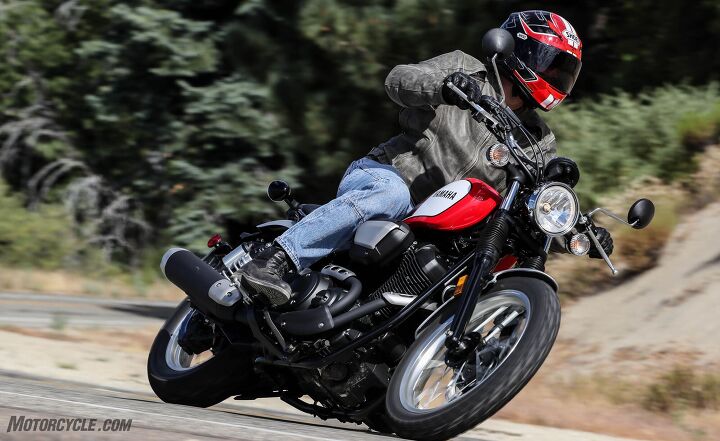
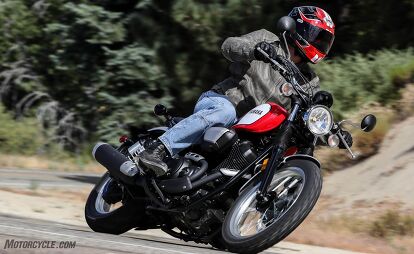



































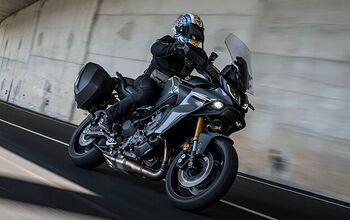
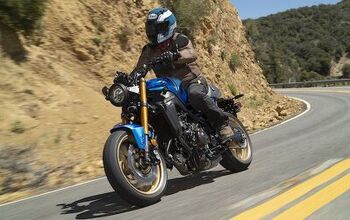
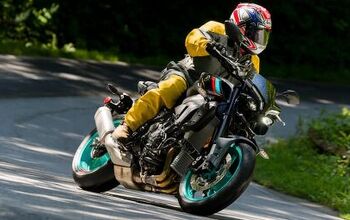
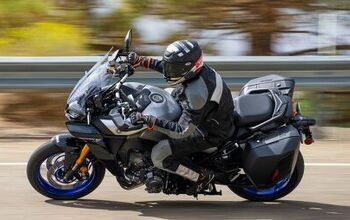





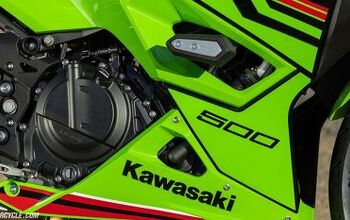





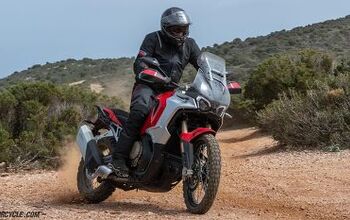

Comments
Join the conversation
I think it looks good and it going to be a good real world ride. Would be great for cruising around the backroads around Little Rock.
looks nice!